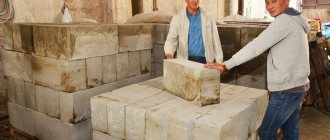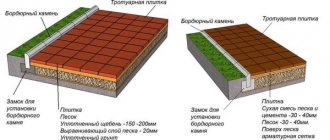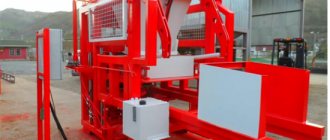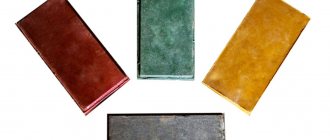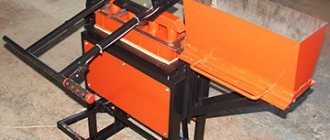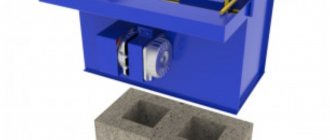You won’t surprise anyone by making paving slabs yourself for personal needs - the technologies are known and tested many times. Homestead owners are most often driven to do homemade work by the desire to save money - when the laying area is large, the difference of a hundred rubles per meter translates into thousands. A competent approach to the process and adherence to technology allows craftsmen to obtain a product whose technical characteristics are not inferior to purchased tiles. Naturally, we are not talking about the luxury segments of clinker, porcelain stoneware or paving stones, but homemade paving slabs are quite capable of competing with the products of small companies that have flooded the market. So Kostya9 took up production and decided to share his experience with all participants of the FORUMHOUSE portal.
Production technology
There are different reasons for making tiles yourself: quality control (you can be confident in the result), reducing the final cost of paving stones. For this we prepare:
- concrete mixer, alternatively - a container for mixing the solution;
- shovel;
- vibrating table;
Vibrating table for making paving slabs
- molds for filling products;
- trowel.
Work should be carried out wearing personal protective equipment (gloves, mask, goggles, headscarf). Further stages of manufacturing paving slabs:
- Calculation and purchase of building materials: cement, sand, water, fillers (crushed stone, plasticizers, etc.), reinforcing elements (mesh, rods, wire), their thickness should be 4-6 mm, which will increase the strength of the coating.
- Creating a sketch of forms: scrap materials and unnecessary parts of structures are used for production. The configuration should be determined: rectangle, polygon.
- Mixing components to prepare cement mortar.
- Preparation and pouring of molds followed by pressing to increase the density and strength of products.
- Drying.
- Removing tiles from molds.
- Repeated drying - done naturally (in the open air), it is recommended to prepare a canopy.
A suitable location on the site is selected. To be able to work comfortably, you should pay attention to several parameters. The quality of the surface - it must be flat so that the concrete hardens correctly (without sagging or unevenness). The dimensions of the site are sufficient to accommodate equipment, tools, and materials. It must be remembered that concrete sets quite quickly, so it is not recommended to place it in several areas. In addition, you need to provide a place where the tiles will dry in the molds.
What does the mixture consist of?
The mixture for creating decorative concrete tiles consists of a number of commercially available ingredients, which must be mixed together in certain proportions. The composition of such products is described in detail below, depending on their scope of application and physical and mechanical characteristics.
For external parts
For the production of facade facing tiles from concrete, the following mineral and synthetic materials are used :
- Portland cement with a grade of no less than M400 - M500 in an amount of up to 10% - 12% of the total composition of the mixture.
- Fine aggregate – quartz or washed river sand without dust inclusions – from 25% to 35%.
- Coarse aggregate - granite crushed stone, marble chips, crushed basalt rock, labradorite, mica, cemented sandstone and other minerals that form the overall structure and appearance of the future product. As a rule, given the small thickness of the tiles, the maximum granulometric composition of coarse aggregate does not exceed 15 - 25 mm.
- Fiber fibers are composite materials of increased strength, which significantly improve the physical and mechanical properties of the product, as they act as structural reinforcement.
- Dry or liquid synthetic pigments to give the tiles the desired shade.
- Antifreeze additive that reduces porosity, which increases the frost resistance of the material to maximum values.
- Water repellents that ensure minimal hygroscopicity of the product structure.
- Plasticizers that help achieve certain elastic deformation values, which reduces the risk of brittle fracture.
The amount of additives and reinforcing elements significantly affects the strength characteristics of products, their frost resistance, water absorption, as well as the durability of the cladding.
Domestic
Unlike facade tiles, for the production of interior decorative elements, the structure of the raw material mixture does not contain the following ingredients :
- To set one shade, as a rule, a dry pigment is used that does not contain toxins or other harmful substances.
- Considering that interior tiles are not constantly exposed to aggressive environments, special interior concrete paint can be used to pigment their surface. This coating will also help reduce the cost of the product.
- Most often, such tiles have a textured back surface with stiffening ribs for better adhesion to adhesive compounds.
- The structure may not contain fiber fibers, since during its operation there is no thermal expansion or contraction.
- Portland cement grade M300 can be used as a binder.
- In addition to cement, to achieve a dense structure and attractive appearance, lime or gypsum can also be added to the tile composition, since the air binder has a low density and can be easily used in rooms with normal temperature and humidity conditions.
The main task of a technologist at any plant when mixing components of interior tiles is to achieve the highest environmental performance, which affects the safe operation of the product for the user.
Preparation of building materials: selection and calculation
In order for the path covering to serve for a long time, you need to determine the appropriate formulation of the finished solution. To make it, the classic concrete recipe is suitable:
- cement – 1 part;
- sand – 2 parts;
- crushed stone - 3 parts.
Composition of mortar for paving slabs
Water is taken in an amount sufficient to obtain a moderately thick mass: not liquid, but not too dense. In order not to prepare the cement mortar with a reserve, you can determine the dimensions of the tile (and therefore the shape) and its volume. This will allow you to find out the amount of concrete. Often paving stones are made 30x30 cm, and a thickness of 4 cm is sufficient. Then the volume will be equal to: 4x30x30 = 3600 cm3 or 0.0036 m3.
At the next stage, the number of such products is calculated, for example, 100 pieces. The total volume of all paving stones will be 0.36 m3. To prepare the solution you will need 6 parts of building materials (the list is given above). Respectively:
INTERESTING: Installing a shower drain
0.36/6 = 0.06 m3.
One part is cement. To determine the amount of sand, you need to multiply the value of 1 fraction by 2 (0.12 m3). Accordingly, take 3 parts of crushed stone or 0.18 m3. To understand how much you need to take (in the equivalent of buckets), you need to know the volume of the container - 0.01 m3. But you should not prepare a limited amount of materials. An additional volume of sand, water, crushed stone, etc. may be required. For this reason, a little more materials are prepared - the volume obtained in the calculations is multiplied by 10%.
Wire is used as reinforcement, but in this case you will have to create the frame yourself. You can do it simpler - prepare a chain-link mesh. A suitable option is a cell size of 5x5 cm. An alternative option is a reinforcing mesh for plaster. You can determine the area of the metal layer by knowing the dimensions of the tile:
30x30 = 900 cm2 or 0.09 m2.
In order for the mesh to retain its properties longer and not rust, it must be galvanized. At the next stage, the forms are prepared. You will have to do them yourself. Determine dimensions and configuration. It is easiest to make square or rectangular tiles at home.
Main results
Tile production is a fairly profitable business. Its prevalence guarantees the required sales volume, and its ease of manufacture makes it easy for even a beginner to start.
In order to save money and gain skills, independent production of products is allowed. This does not require a lot of money, but you need to be patient. If you make tiles purely for your own needs and in small quantities, purchasing all the equipment is completely unprofitable.
Thanks to the wide range of tile types, it is possible to create entire compositions. Here everything depends on the imagination of the owner of the site or the design decision.
Those who are not too limited in their budget for landscaping their yard will certainly be interested in the production of tiles from Kevlar concrete. With its help, finishing areas will not only become visually attractive, but will also gain enviable durability.
How to make forms
The main thing you should know when studying the question of how to make a mold for paving slabs with your own hands is the choice of material. It is necessary to study the reserves of old structures. Some people have boards left in their garage/shed, others have plastic panels. But the second option has disadvantages - it can burst under the influence of excess loads. Wood is the most suitable option.
Boards with a width of at least 30 cm are suitable. They are cut into pieces of different lengths, which depends on the type of shape. When the boards are connected to each other, you need to remember that they should be located at a distance of at least 30 cm from each other (the length of the side of the tile). The length of the board may vary. In the example, we will consider an option with a length of 1 m. The boards are placed parallel to each other, then transverse inserts are installed - shorter ones (30 cm each). Wood screws are used for fixation. Moreover, they are installed from the outside.
Important! You should check the position of the boards - install corners, they should also be fixed outside the structure. This will allow you to obtain products with even angles (90°).
It is not recommended to make a large-sized form. When moving, there is a possibility that the structure will break.
How to make concrete solution
To prevent the solution from staining the surface of the area (asphalt, concrete, other tiles), you need to use polyethylene, a large container or other available devices. You can mix the components in different ways. Options available for making your own concrete:
- combine the dry ingredients in one container, add water (in small portions) until the solution reaches the desired consistency;
- prepare cement laitance: pour water, add cement, then combine the resulting solution with sand and crushed stone;
- First, dry solid fraction components (crushed stone, sand) are mixed, cement mortar is prepared separately, and then the mixtures are combined in one container.
INTERESTING: DIY wooden staircase to the second floor in a private house
A concrete mixer is used if it is necessary to immediately produce a large amount of paving slabs. Instructions for making concrete in this case:
- The concrete mixer turns on.
- While the drum is rotating, water is poured.
- Cement is poured in dry form.
- When laitance appears, the remaining components are added.
How to pour the solution into a mold
The process is simple, but also has its own nuances, like any action described above. When deciding how to make paving slabs, study the instructions:
- To prevent products from sticking to the mold, it is recommended to treat its inner walls with technical oil.
- The solution is poured to half the height of the molds.
- The concrete is pressed.
- A reinforcing layer is laid - a mesh that has been previously cut to the size of the wooden frame.
- Fill the mold to the brim.
- Re-pressing is carried out.
- The surface is leveled.
- Sprinkle with dry cement.
- After 1 day, the tiles are removed from the mold and left in the open air, but only in the shade.
Drying
At home, it is quite possible to thoroughly dry the finished product.
It is important that the tile gains at least a third of its strength before being removed from the mold. At lower strength values, the tile coating will be brittle and short-lived.
At home, this technological stage can be represented by:
- natural drying;
- drying inside the steam chamber;
- drying using infrared thermal mats.
In summer, drying is carried out outdoors or indoors.
The optimal temperature should be 18-20°C. The minimum temperature suitable for drying tiles cannot be lower than 10°C.
Features of the process of manufacturing paving slabs on a vibrating table
Vibrating table for paving slabs
When concrete is compacted, different functions are performed:
- compaction of the mass, which increases its hardness and strength;
- eliminating air bubbles.
An excellent result is provided by equipment that distributes vibration, for example, a vibrating table. You won't be able to achieve this result manually. Usually in this case a shovel, a hard rod, etc. are used.
Making a vibrating table
It seems that the structure of the vibrating table is very simple. In fact, in its manufacture you will need a lot of knowledge in the field of welding and plumbing. The most commonly used option is in the form of a frame made of metal profiles. There is a table top on top. In order to use the vibration method, movable elements are provided under the table. These are hinges or springs.
The vibration spreads to the concrete mixture in the forms that are installed on top of the countertop. As a result, air bubbles are eliminated and the mass becomes more uniform. At the same time, the compaction process will begin.
Important! To increase the number of molds, use a large tabletop - from 180 cm on one side. The power for large-sized products is also much higher - from 250 W.
The rate of equipment wear depends on production capacity. The following stages of creating a vibrating table:
- The electric motor will be a motor from large equipment, for example, a washing machine.
- A frame is prepared, for which a profile pipe with a cross section of 40x40 mm is used. It looks like vertical supports connected by crossbars. The most reliable fastening method is welding. If you use a standard mount, it will be subject to vibrations and will therefore loosen very quickly.
- Tubes are welded at the corners. They are pre-cut, the length should be 5-10 cm. An alternative option is M18 bolts (the caps should be pointing down). They function as a hose attachment.
- You can increase the strength of the structure by welding cross members from a corner or the same profile pipe.
- The racks must be placed on metal soles, their parameters are: 55x55 mm. The recommended sheet thickness is 1.5 mm.
INTERESTING: DIY frame house step by step instructions
How to make a tabletop for a vibrating table
The material is prepared - a metal sheet, and its thickness should be significant from 6 to 10 mm. Sides are welded on the front side, which will perform a protective function - the form of water will not fall off the table under the influence of vibration. On the other side there should be sections of profile pipes. The finished tabletop is placed on top of the assembled metal frame. Its springs should be on top of the pins in the corners. The electrical part is connected - the cable with the unit.
Mass production of paving slabs
In order for the equipment to withstand the production of large quantities of tiles, this method is mechanized. The main stages of product manufacturing are standard:
- Preparation of cement mixture.
- Laying the solution into the mold.
- Installation of reinforcement.
- Refilling the mold.
- Compacting concrete using a vibrating table.
After removing the tiles from the mold, it becomes possible to fill it again. However, it is important to turn off the vibrating table in time. When the form is filled with concrete, the equipment is turned on again. This process is endless - the frequency of repetition of the cycle depends on the number of tiles that need to be purchased.
Reducing the cost of tiles
If you plan to make a vibrating table with your own hands, this will already have a positive effect on the cost of the tiles. The reason is the lack of margins from the store, the manufacturer and the work of the staff. If you do not plan to drive a car on the site, you can choose the option of reducing the thickness of the products. This will negatively affect the strength and the tile will have little service.
Considering recipe options:
- 1:2:4;
- 1:3:3.
Along with a decrease in strength, other changes are also noted, for example, an increase in the volume of crushed stone. You can do without it altogether, but the quality of the products will decrease.
Cost of paving slabs for 2022
Requirements for organizing a workshop
To organize your own workshop for the production of decorative stone tiles, you must provide for the installation of the following types of equipment :
The room must have overhead crane beams, hoists and other lifting equipment.- The ceiling height must be at least 4.2 - 5.4 m to the bottom of the nearest protruding building structure.
- The workshop must be provided with effective supply and exhaust ventilation with mechanical drive.
- To reduce production costs, it is recommended to install a recycling system.
- Each power equipment that requires connection to a 3-phase network must have its own circuit breaker with a calculated current strength.
- The dosage of ingredients should be done using electronic scales to avoid mixing errors.
- Mixing of the composition should take place using electric mixers, eliminating the heterogeneity of the mixture.
- After forming, the concrete must be compacted on a vibrating table with high-frequency vibration function.
- The steaming chamber should ensure a reduction in the hardening time of concrete products to minimum values, which allows for maximum savings on manufacturing costs.
- It is recommended to install all machines with a numerical control (CNC) function, and organize automatic transport carts between stations to achieve complete automation of the process.
- If a batching plant is available, it is recommended to install a separate heating system for inert components to obtain concrete without defects and damage to quality.
When installing a batching plant, the future business owner should study the technological capabilities of the equipment in advance, since it can significantly increase profitability through the sale of ready-mixed concrete, provided that they have their own or leasing vehicle mixers for its transportation.
Is certification required?
Mandatory certification of such tiles is required to be able to participate in tenders for the supply of products when it is necessary to cladding the facades of permanent apartment buildings.
The official document takes into account a number of important parameters:
- Strength characteristics of products.
- Consistency of the chemical composition and formulation of products.
- Compliance of technical conditions developed by production enterprises with the requirements of current state regulations.
- Providing the necessary physical and mechanical characteristics.
- Reducing the number of defects in a batch of products.
- No significant deviations from geometric dimensions, since GOST regulates these errors and reduces them to a minimum, obliging manufacturers to comply with the requirements.
Even if the manufacturer does not plan to enter the large-scale capital construction market, the presence of a certificate of conformity significantly increases the authority of the product in the eyes of the consumer, which also makes it possible to set a higher retail price for the product.
Alternative option
There are molds without a bottom on sale. This makes it easier to remove the tiles. In addition, there are products of different configurations, for example, you can get polygonal tiles of irregular shape (with a large number of corners). Instructions for making paving stones:
- Preparation. At the site where the tiles are planned to be installed, sand is poured, moistened and compacted.
- Mix the components to prepare the solution.
- Fill the form. The solution in it just needs to be aligned along the edge.
- After 1 hour, the concrete will begin to harden, the tiles are removed to dry in the open air.
Making paving stones with your own hands
There are also molds made of silicone and plastic with a bottom. Their advantage is the presence of a pattern on the back side. This will allow you to obtain patterned products.
Important! You can make tiles of a different color. To do this, a dye is prepared and added to the composition along with the dry ingredients. This will avoid the formation of lumps.
In addition, there are a huge number of options for decorating the tiles on the front side. It could be pebbles, mosaics, colored glass (broken). The choice must be made taking into account the features of the site’s exterior and landscape design.
Broken glass paving slabs
Equipment
Equipment for the production of ceramic tiles is widely represented on the market, and it is constantly being improved. The choice is great, you can purchase individual units for small factories or powerful high-performance mechanisms for mass production, it all depends on the intended purpose.
This machine makes designs on tiles
This is what's happening inside. This is exactly how the drawing is applied. Very similar to printing. True, the ink of such a printer is special.
An approximate list is compiled taking into account the tasks performed by the equipment:
- Preparation and mixing of components into a primary mass. Ball mills, various crushers, distribution tower dryers, special mixers. Concrete mixers are often mentioned on the Internet. If it’s a small handicraft production, why not;
- Molding. Press, extruders, injection molds;
- Pre-drying. Single-row high-speed drying on mesh or roller conveyors.
- Glazing. Airbrushes, spun and cone automatic machines, disc sprayers, silk-screen printing machines, tubular and bucket dispensers;
- Burning. Gas or electric tunnel ovens with conveyor and programmable temperature control.
If individual mechanisms are installed in accordance with technological requirements, combined with automatic transport and a common control system, then a line for the production of ceramic tiles is formed.
This is a mill. The real one, only for the production of tile raw materials
This is the optimal production configuration. Advances in computer science make it possible to computerize the entire process and reduce human participation to a minimum. Leading ceramic manufacturers use just such lines. For example, ceramic tiles produced in different developed countries are almost entirely made using such equipment.
